- thermometer
- hydrometer
- glass tube
- rubber bulb
- charger-starter
Frequency: Every 15,000 km, check the level and density of the electrolyte.
Regularly clean the battery from dust and dirt. If the top cover is cracked or bulging, replace the battery.
The electrolyte must be transparent. A brown tint indicates shedding of the active mass of the plates - the battery needs to be changed.
Attention! During operation, the electrolyte level gradually decreases due to the evaporation of water, which is part of it. To restore the level, add only distilled water to the battery.
Warning! When checking the density, be careful: the electrolyte contains sulfuric acid! Drops of electrolyte that have fallen on parts of the car or on open areas of the body, immediately rinse with plenty of water.
Attention! Do not smoke or use open flames while charging the battery.
Attention! Before charging, remove the battery from the vehicle, otherwise "boiled" electrolyte can splash out on the body and parts of the car.
Table 1. Correction of electrolyte density depending on temperature
Electrolyte temperature,°С | Correction, g/cm3 |
-40 to -26 | -0,04 |
-25 to -11 | -0,03 |
-10 to 4 | -0,02 |
5 to 19 | -0,01 |
20 to 30 | -0,00 |
31 to 45 | 0,01 |
Table 2. Electrolyte density at 25°С, g/cm3
| climatic region (average monthly air temperature in January,°С) | Season | Fully charged battery | Battery is charged | |
by 25% | by 50% | |||
Very cold | Winter | 1,30 | 1,26 | 1,22 |
Cold | All year round | 1,28 | 1,24 | 1,20 |
Moderate | All year round | 1,28 | 1,24 | 1,20 |
warm humid | All year round | 1,23 | 1,19 | 1,15 |
hot dry | All year round | 1,23 | 1,19 | 1,15 |
Table 3. Approximate norms for adjusting the density of the electrolyte
Required electrolyte density in the battery, g/cm3 | 1,24 | 1,26 | 1,28 | 1,30 |
| Real electrolyte density, g/cm3 | The volume of electrolyte removed from the battery, cm3 | |||
1,15 | 254 | 290 | 342 | 396 |
1,16 | 220 | 275 | 330 | 385 |
1,17 | 201 | 259 | 316 | 374 |
1,18 | 181 | 241 | 301 | 362 |
1,19 | 158 | 222 | 285 | 348 |
1,20 | 133 | 200 | 266 | 333 |
1,21 | 105 | 176 | 246 | 316 |
1,22 | 74 | 149 | 223 | 242 |
1,23 | 40 | 119 | 198 | 277 |
1,24 | 0 | 84 | 169 | 253 |
1,25 | 24 | 45 | 136 | 226 |
1,26 | 47 | 0 | 97 | 194 |
1,27 | 68 | 23 | 53 | 158 |
1,28 | 87 | 44 | 0 | 115 |
1,29 | 105 | 63 | 21 | 63 |
1,30 | 112 | 82 | 41 | 0 |
1,31 | 138 | 90 | 59 | 20 |
| After removing the electrolyte, it is necessary to add the same amount of electrolyte with a density of 1.40 g/cm3. | |
| After removing the electrolyte, add the same amount of distilled water. |
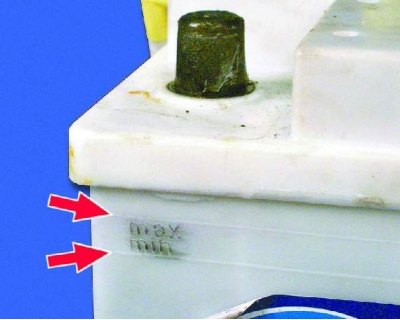
1. If the battery has a translucent case, the electrolyte level is determined visually: it must be between the marks "MIN" And "MAX" on the side of the battery.
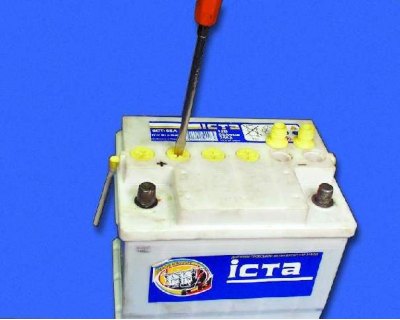
2. If the battery case is opaque, unscrew the six plugs on the cover.
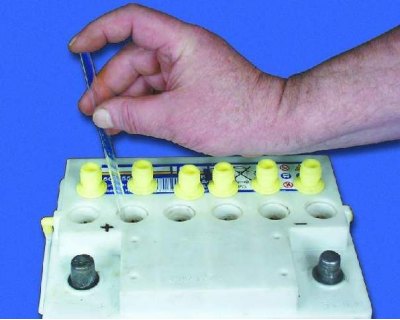
3. Check the electrolyte level in the first battery cell by inserting a glass tube (it is sold with a hydrometer) into the hole until it stops in the safety net and clamping the tube with your finger...
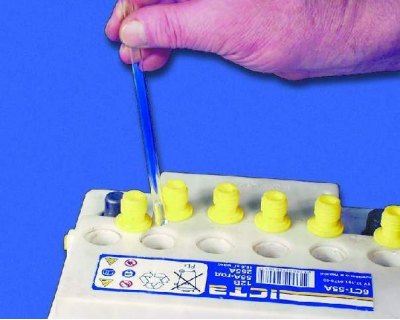
4....pick up the handset. The electrolyte level should be 10–15 mm.
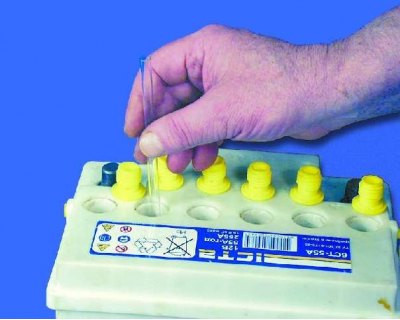
5. Insert a tube into the hole and drain the electrolyte. In the same way, check the level in the other banks of the battery. If any of the jars are low, add distilled water to them to the recommended level (mark "MIN" or 10–15 mm level in the tube).
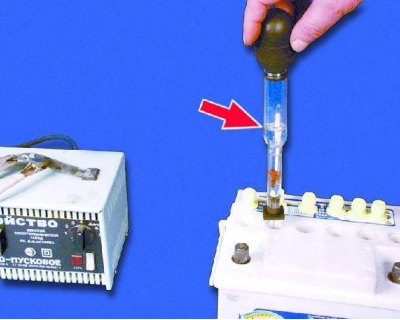
6. After pouring, it is possible to measure the density of the electrolyte only after two hours: the water must mix with the electrolyte. To check the density, insert the hydrometer into the hole until it stops in the safety net and suck the electrolyte with a pear so that the hydrometer float floats.
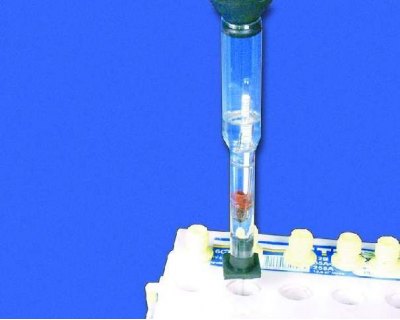
7. The division on the float, located at the level of the electrolyte, shows its density, which should be 1.28 g / cm3 for temperate climate (at an electrolyte temperature of 25°C). The density depends on the temperature of the electrolyte, so make a correction to the measurement result (see table. 1). By this indicator, you can judge the degree of battery discharge (see table. 3). If the density is lower than specified or differs in banks by more than 0.02 g/cm3, need to recharge the battery.
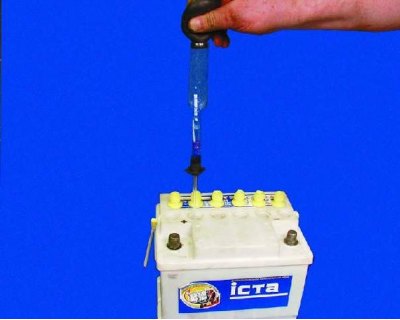
8. Drain the electrolyte from the hydrometer into a battery can.
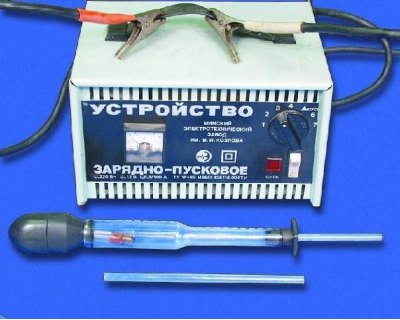
9. To charge the battery, use the charger or charger according to the instructions.
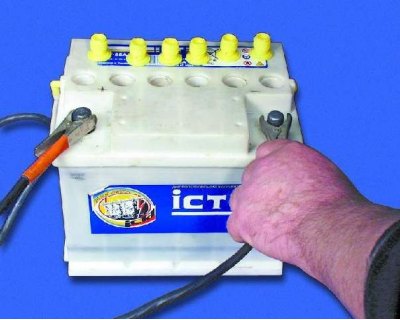
12. During charging, regularly check the temperature and density of the electrolyte. If the electrolyte temperature exceeds 40°C, reduce the charging current by half or interrupt charging and let the electrolyte cool down to 27°C.
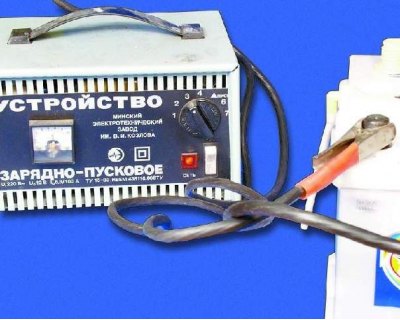
10. Remove all plugs of cans and connect the charger wires to the battery terminals, observing the polarity, then turn on the charger.
11. Set charging current equal to 0.1 battery capacity (for a battery with a capacity of 5 Ah - 5.5 A; for a battery with a capacity of 65 Ah - 6.5 A, etc.). Adjust the charging current periodically while charging.
13. If within two hours the density does not change and a violent "boiling" electrolyte, the battery is fully charged. First turn off the charger, then disconnect the wires from the battery terminals.
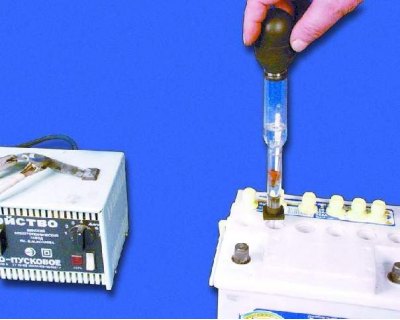
14. Measure the density of the electrolyte in all banks. If it is more than normal, suck out a part of the electrolyte from the jar with a rubber bulb and add the same volume of distilled water. If the density of the electrolyte is less than normal, pump out a part of the electrolyte with a hydrometer and add the same amount of electrolyte with a density of 1.40 g/cm3 (see table. 3). Then reconnect the charger and charge the battery for 30 minutes. Again measure the density of the electrolyte and, if necessary, bring it to the norm, as indicated above.
